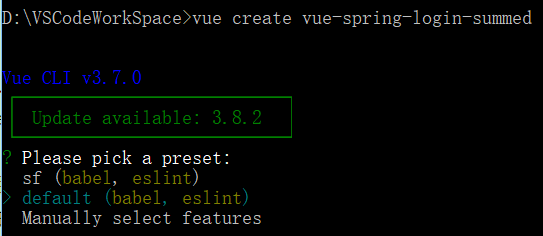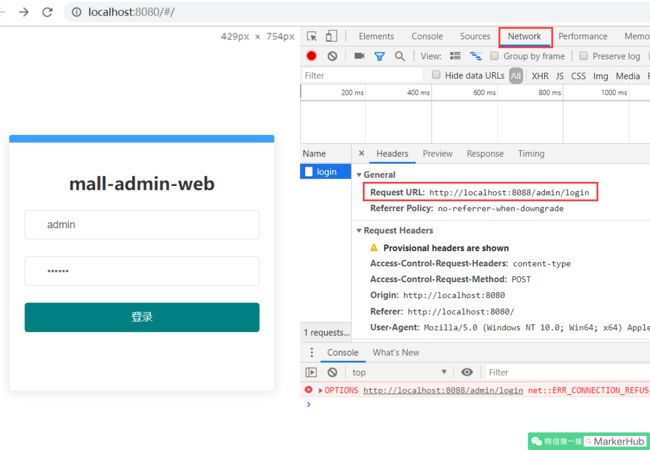小Hub领读:
一个完整的Spirngboot+vue实现登录的小例子,我之前在vueblog中也搞过,哈哈,再来回顾一下!
作者:Eli Shaw
一、简述
最近学习使用 Vue 实现前端后端分离,在 Github 上有一个很好的开源项目:mall,正所谓百看不如一练,自己动手实现了一个 Springboot+Vue 的登录操作,在此记录一下踩过的坑。
文章最后补充两端的 GitHub 代码,之所以放在最后,是因为文章写的很细致了,动手操作一下会更有帮忙,如果有很大出入可以比对原码,找找问题。
二、开发工具
VSCode
IDEA
Vue 的安装就不说了,有很多文章,但是 Springboot+Vue 整合的完整文章相对较少,所以我主要记录一下这两端整合时的内容。
(Vue 安装后就会有 npm 或 cnpm,相应的介绍也不说了,Vue 官网可查看)
一、打开 cmd 创建 Vue 项目,并添加 Vue 依赖的框架:
1\. 创建 Vue 项目 (进入自己想创建的文件夹位置,我放在 D:\VSCodeWorkSpace),创建语句 vue create vue-spring-login-summed,方向键选择创建方式,我选择的默认
2\. 进入到创建的 Vue 项目目录,添加依赖框架:
cd vue-spring-login-summed (进入到项目根目录)
vue add element (添加 element,一个 element 风格的 UI 框架)
npm install axios (安装 axios,用于网络请求)
npm install vuex --save(安装 Vuex,用于管理状态)
npm install vue-router (安装 路由,用于实现两个 Vue 页面的跳转)以上命令截图如下:
1) 添加 Element
2) 添加 axios
3) 添加 Vuex
4) 添加 路由
到此相关依赖的架包添加完毕,输入 code . 打开 VSCode
二、添加目录结构
在 VSCode 下看到 Vue 整体项目结构如下
现在需要创建相应功能的目录结构,进行分层开发,需要在 src 目录下创建下面几个目录
api (网络请求接口包)
router (路由配置包)
store (Vuex 状态管理包)
utils (工具包)
views (vue 视图包,存放所有 vue 代码,可根据功能模块进行相应分包)创建后的目录结构如下
三、运行项目
现在可以运行项目了,在 VSCode 菜单栏依次选择:终端 —— 运行任务...
这里使用的是 serve 模式,即开发模式运行的项目
在浏览器输入:http://localhost:8080/
这是 Vue 默认的页面,代表项目创建成功了,在进行代码开发前,先贴上项目整体结构,防止不知道在哪创建
四、View 层代码编写
编写三个 vue 文件:login.vue(登录页面)、success.vue(登录成功页面)、error.vue(登录失败页面)
1.login.vue
代码如下 (比较懒,直接从 mall 扒下来的代码,去掉了一些功能)
mall-admin-web
登录
2.success.vue
Welcome!{{msg}}
3.error.vue
登录错误:{{msg}}
五、路由
页面写好了,我们需要依次显示这三个页面,这里我们统一使用路由来管理显示页面,路由的官方文档见:vue 路由
本着先实践,后理解的码农学习方式。我们先使用路由显示三个页面后,再去理解 Vue 路由这个功能点。
1\. 创建路由配置文件
在刚才建立的 router 文件夹下创建一个 index.js 文件,内容如下
import Vue from 'vue' //引入 Vue
import VueRouter from 'vue-router' //引入 Vue 路由
Vue.use(VueRouter); //安装插件
export const constantRouterMap = \[
//配置默认的路径,默认显示登录页
{ path: '/', component: () => import('@/views/login')},
//配置登录成功页面,使用时需要使用 path 路径来实现跳转
{ path: '/success', component: () => import('@/views/success')},
//配置登录失败页面,使用时需要使用 path 路径来实现跳转
{ path: '/error', component: () => import('@/views/error'), hidden: true }
\]
export default new VueRouter({
// mode: 'history', //后端支持可开
scrollBehavior: () => ({ y: 0 }),
routes: constantRouterMap //指定路由列表
})2\. 将路由添加到程序入口
路由配置文件写好,我们需要把他引入到 main.js 中,在项目的 src 目录根节点下,找到 main.js,添加内容如下:
import Vue from 'vue'
import App from './App.vue'
import './plugins/element.js'
import router from './router' //引入路由配置
Vue.config.productionTip = false
new Vue({
render: h => h(App),
router, //使用路由配置
}).$mount('#app')3\. 配置路由的出入口
现在路由已经完全引入到项目了,但是路由还需要一个出入口,这个出入口用来告诉路由将路由的内容显示在这里。上面 main.js 配置的第一个 vue 显示页面为 App.vue ,因此我们修改 App.vue 内容如下
现在保存 App.vue 文件后,当前项目会被重新装载运行,在刚才浏览的界面就会看到登录界面如下:
4\. 路由跳转
在 login.vue 中可以使用 this.$router.push({path: "路径"}) 来跳转到指定路径的路由组件中,下面是通过路由跳转到 error.vue 与 success.vue 的代码
this.$router.push({path: "/success"}); //跳转到成功页
或
this.$router.push({path: "/error"}); //跳转到失败页六、使用 Vuex + Axios 方式进行网络请求
1.Axios
axios 是一个网络请求构架,官方推荐使用这种方式进行 http 的请求。
1) 在 utils 包下封装一个请求工具类 request.js
import axios from 'axios' //引入 axios
import baseUrl from '../api/baseUrl' //使用环境变量 + 模式的方式定义基础URL
// 创建 axios 实例
const service = axios.create({
baseURL: baseUrl, // api 的 base\_url
timeout: 15000, // 请求超时时间
})
export default service这里的 baseUrl 涉及 Vue CLI3 的环境变量与模式的概念,见:Vue 环境变量和模式 (设置通用 baseUrl)
2) 登录请求接口 API
在 api 文件夹下,创建一个登录 API 文件:login.js
import request from '@/utils/request' //引入封装好的 axios 请求
export function login(username, password) { //登录接口
return request({ //使用封装好的 axios 进行网络请求
url: '/admin/login',
method: 'post',
data: { //提交的数据
username,
password
}
})
}2\. 使用 Vuex 封装 axios
Vuex 是一个状态管理构架,官方文档:Vuex
1) 封装 Vuex 中的 module
在 store 文件夹下创建一个 modules 文件夹,然后在此文件夹下创建一个 user.js 文件
import { login } from '@/api/login'//引入登录 api 接口
const user = {
actions: {
// 登录
Login({ commit }, userInfo) { //定义 Login 方法,在组件中使用 this.$store.dispatch("Login") 调用
const username = userInfo.username.trim()
return new Promise((resolve, reject) => { //封装一个 Promise
login(username, userInfo.password).then(response => { //使用 login 接口进行网络请求
commit('') //提交一个 mutation,通知状态改变
resolve(response) //将结果封装进 Promise
}).catch(error => {
reject(error)
})
})
},
}
}
export default user这里的代码值得解释一下:官方文档对应:Vuex actions
1\. 首先引入 login 接口,之后使用登录接口进行网络请求。
2\. 定义一个 名为 Login 的 action 方法,Vue 组件通过 this.$store.dispatch("Login") 调用
3.Promise,这个类很有意思,官方的解释是 “store.dispatch 可以处理被触发的 action 的处理函数返回的 Promise,并且 store.dispatch 仍旧返回 Promise”。这话的意思组件中的 dispatch 返回的仍是一个 Promise 类,因此推测 Promise 中的两个方法 resolve() 与 reject() 分别对应 dispatch 中的 then 与 catch。
2) 创建 Vuex
在 store 文件夹下创建一个 index.js 文件
import Vue from 'vue' //引入 Vue
import Vuex from 'vuex' //引入 Vuex
import user from './modules/user' //引入 user module
Vue.use(Vuex)
const store = new Vuex.Store({
modules: {
user //使用 user.js 中的 action
}
})
export default store3) 将 Vuex 添加到 main.js 文件
修改之前的 main.js 文件如下:
import Vue from 'vue'
import App from './App.vue'
import './plugins/element.js'
import router from './router' //引入路由配置
import store from './store' //引入 Vuex 状态管理
Vue.config.productionTip = false
new Vue({
render: h => h(App),
router, //使用路由配置
store //使用 Vuex 进行状态管理
}).$mount('#app')重新运行项目,在 Chrome 浏览器中进入调试模式,点击登录按钮
可以看到有发送一个 8088 端口的请求,至此 Vue 端的所有代码已经完成。
\-------------------------------Springboot 开发 -------------------------------
项目创建就不提了,网上有很多,只要使用 Spring Assistant 创建就好。
整体目录结构如下
1\. 在 application.yml 修改端口号
不要和 Vue 在一个 8080 端口上:
server:
port: 80882\. 解决跨域问题
这里有一个跨域问题,即 Vue 使用 8080 端口,要访问 8088 端口的服务器,会报错。错误信息如下:
Access to XMLHttpRequest at 'http://localhost:8088/admin/login' from origin 'http://localhost:8080' has been blocked by CORS policy: Response to preflight request doesn't pass access control check: No'Access-Control-Allow-Origin' header is present on the requested resource.
这个问题在 Vue 端或在 Springboot 端处理都可以,我在 Springboot 端处理的,写一个 CorsConfig 类内容如下,不要忘了 @Configuration 注解。
@Configuration
public class CorsConfig {
private CorsConfiguration buildConfig() {
CorsConfiguration corsConfiguration = new CorsConfiguration();
corsConfiguration.addAllowedOrigin("\*"); // 1
corsConfiguration.addAllowedHeader("\*"); // 2
corsConfiguration.addAllowedMethod("\*"); // 3
return corsConfiguration;
}
@Bean
public CorsFilter corsFilter() {
UrlBasedCorsConfigurationSource source = new UrlBasedCorsConfigurationSource();
source.registerCorsConfiguration("/\*\*", buildConfig()); // 4
return new CorsFilter(source);
}
}3.IErrorCode 接口
Java 版本
public interface IErrorCode {
long getCode();
String getMessage();
}Kotlin 版本
interface IErrorCode {
fun getCode(): Long
fun getMessage(): String
}4.CommonResult 类
Java 版本
public class CommonResult {
private long code;
private String message;
private T data;
protected CommonResult() {
}
protected CommonResult(long code, String message, T data) {
this.code = code;
this.message = message;
this.data = data;
}
/\*\*
\* 成功返回结果
\*
\* @param data 获取的数据
\*/
public static CommonResult success(T data) {
return new CommonResult(ResultCode.SUCCESS.getCode(), ResultCode.SUCCESS.getMessage(), data);
}
/\*\*
\* 成功返回结果
\*
\* @param data 获取的数据
\* @param message 提示信息
\*/
public static CommonResult success(T data, String message) {
return new CommonResult(ResultCode.SUCCESS.getCode(), message, data);
}
/\*\*
\* 失败返回结果
\*
\* @param errorCode 错误码
\*/
public static CommonResult failed(IErrorCode errorCode) {
return new CommonResult(errorCode.getCode(), errorCode.getMessage(), null);
}
/\*\*
\* 失败返回结果
\*
\* @param message 提示信息
\*/
public static CommonResult failed(String message) {
return new CommonResult(ResultCode.FAILED.getCode(), message, null);
}
/\*\*
\* 失败返回结果
\*/
public static CommonResult failed() {
return failed(ResultCode.FAILED);
}
/\*\*
\* 参数验证失败返回结果
\*/
public static CommonResult validateFailed() {
return failed(ResultCode.VALIDATE\_FAILED);
}
/\*\*
\* 参数验证失败返回结果
\*
\* @param message 提示信息
\*/
public static CommonResult validateFailed(String message) {
return new CommonResult(ResultCode.VALIDATE\_FAILED.getCode(), message, null);
}
/\*\*
\* 未登录返回结果
\*/
public static CommonResult unauthorized(T data) {
return new CommonResult(ResultCode.UNAUTHORIZED.getCode(), ResultCode.UNAUTHORIZED.getMessage(), data);
}
/\*\*
\* 未授权返回结果
\*/
public static CommonResult forbidden(T data) {
return new CommonResult(ResultCode.FORBIDDEN.getCode(), ResultCode.FORBIDDEN.getMessage(), data);
}
public long getCode() {
return code;
}
public void setCode(long code) {
this.code = code;
}
public String getMessage() {
return message;
}
public void setMessage(String message) {
this.message = message;
}
public T getData() {
return data;
}
public void setData(T data) {
this.data = data;
}
} Kotlin 版本
class CommonResult {
var code: Long = 0
var message: String? = null
var data: T? = null
constructor(code: Long, message: String, data: T?) {
this.code = code
this.message = message
this.data = data
}
companion object {
/\*\*
\* 成功返回结果
\* @param data 获取的数据
\*/
fun success(data: T): CommonResult {
return CommonResult(ResultCode.SUCCESS.getCode(), ResultCode.SUCCESS.getMessage(), data)
}
/\*\*
\* 成功返回结果
\* @param data 获取的数据
\* @param message 提示信息
\*/
fun success(data: T, message: String): CommonResult {
return CommonResult(ResultCode.SUCCESS.getCode(), message, data)
}
/\*\*
\* 失败返回结果
\* @param errorCode 错误码
\*/
fun failed(errorCode: IErrorCode): CommonResult {
return CommonResult(errorCode.getCode(), errorCode.getMessage(), null)
}
/\*\*
\* 失败返回结果
\* @param message 提示信息
\*/
fun failed(message: String): CommonResult {
return CommonResult(ResultCode.FAILED.getCode(), message, null)
}
/\*\*
\* 失败返回结果
\*/
fun failed(): CommonResult {
return failed(ResultCode.FAILED)
}
/\*\*
\* 参数验证失败返回结果
\*/
fun validateFailed(): CommonResult {
return failed(ResultCode.VALIDATE\_FAILED)
}
/\*\*
\* 参数验证失败返回结果
\* @param message 提示信息
\*/
fun validateFailed(message: String): CommonResult {
return CommonResult(ResultCode.VALIDATE\_FAILED.getCode(), message, null)
}
/\*\*
\* 未登录返回结果
\*/
fun unauthorized(data: T): CommonResult {
return CommonResult(ResultCode.UNAUTHORIZED.getCode(), ResultCode.UNAUTHORIZED.getMessage(), data)
}
/\*\*
\* 未授权返回结果
\*/
fun forbidden(data: T): CommonResult {
return CommonResult(ResultCode.FORBIDDEN.getCode(), ResultCode.FORBIDDEN.getMessage(), data)
}
}
} 5.ResultCode 枚举
Java 版本
public enum ResultCode implements IErrorCode {
SUCCESS(200, "操作成功"),
FAILED(500, "操作失败"),
VALIDATE\_FAILED(404, "参数检验失败"),
UNAUTHORIZED(401, "暂未登录或token已经过期"),
FORBIDDEN(403, "没有相关权限");
private long code;
private String message;
private ResultCode(long code, String message) {
this.code = code;
this.message = message;
}
public long getCode() {
return code;
}
public String getMessage() {
return message;
}
}Kotlin 版本
enum class ResultCode(private val code: Long, private val message: String) : IErrorCode {
SUCCESS(200, "操作成功"),
FAILED(500, "操作失败"),
VALIDATE\_FAILED(404, "参数检验失败"),
UNAUTHORIZED(401, "暂未登录或token已经过期"),
FORBIDDEN(403, "没有相关权限");
override fun getCode(): Long {
return code
}
override fun getMessage(): String {
return message
}
}6.User 类
Java 版本
public class User {
private int id;
private String username;
private String password;
public int getId() {
return id;
}
public void setId(int id) {
this.id = id;
}
public String getUsername() {
return username;
}
public void setUsername(String username) {
this.username = username;
}
public String getPassword() {
return password;
}
public void setPassword(String password) {
this.password = password;
}
}Kotlin 版本
data class User(
val id: Int,
val username: String,
val password: String)7.LoginController 类
Java 版本
@RestController
public class LoginController {
@RequestMapping(value = "/admin/login", method = RequestMethod.POST)
public CommonResult login(@RequestBody User user) {
if (user.getUsername().equals("admin") && user.getPassword().equals("123456"))
return CommonResult.success("admin");
else
return CommonResult.validateFailed();
}
}Kotlin 版本
@RestController //此注解是 @ResponseBody 和 @Controller 的组合注解,可返回一个 JSON
class LoginController {
@RequestMapping(value = \["/admin/login"\], method = \[RequestMethod.POST\])
fun admin(@RequestBody user: User): CommonResult<\*> {
return if (user.username == "admin" && user.password == "123456") {
CommonResult.success("admin")
} else {
CommonResult.validateFailed()
}
}
}启动两端程序
输入正确的账号密码
输入错误的账号密码
七、GitHub 源码地址
vue 端:https://github.com/xiaojinlai/vue-spring-login-summed
Java 端:https://github.com/xiaojinlai/vue-login-java
Java 端 - Kotlin 版本:https://github.com/xiaojinlai/vue-login-kotlin
注:Kotlin 版本只是我本人用习惯了 Kotlin,就功能而言与 Java 是一样的。大家如果不喜欢可以不用理会,如果有感兴趣的可以看看,Kotlin 是 Google 推出的一种简洁性语言,主推在 Android 上,用习惯后还是蛮喜欢的。学习起来也不难,内容也不多,推荐一个学习 Kotlin 的网址:https://www.kotlincn.net/docs/reference/
(完)
推荐阅读:
B站100K播放量,SpringBoot+Vue前后端分离完整入门教程!
分享一套SpringBoot开发博客系统源码,以及完整开发文档!速度保存!


















